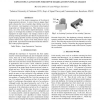Free Online Productivity Tools
i2Speak
i2Symbol
i2OCR
iTex2Img
iWeb2Print
iWeb2Shot
i2Type
iPdf2Split
iPdf2Merge
i2Bopomofo
i2Arabic
i2Style
i2Image
i2PDF
iLatex2Rtf
Sci2ools
ICASSP
2009
IEEE
2009
IEEE
Exploiting T-junctions for depth segregation in single images
Occlusion is one of the major consequences of the physical image generation process: it occurs when an opaque object partly obscures the view of another object further away from the viewpoint. Local signatures of occlusion in the projected image plane are T-shaped junctions. They represent, in some sense, one of the most primitive depth information. In this paper, we investigate the usefulness of T-junctions for depth segregation in single images. Our strategy consists in incorporating ordering information provided by T-junctions into a region merging algorithm and then reasoning about the depth relations between the regions of the final partition using a graph model. Experimental results demonstrate the effectiveness of the proposed approach.
Depth Segregation | ICASSP 2009 | Physical Image Generation | Primitive Depth Information | Signal Processing |
| Added | 21 May 2010 |
| Updated | 21 May 2010 |
| Type | Conference |
| Year | 2009 |
| Where | ICASSP |
| Authors | Mariella Dimiccoli, Philippe Salembier |
Comments (0)

